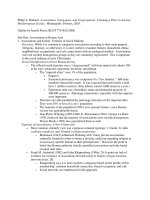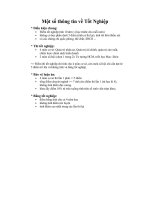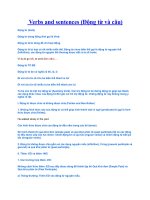Tài liệu Faces and a Vase - Vẽ khuôn mặt pptx
Bạn đang xem bản rút gọn của tài liệu. Xem và tải ngay bản đầy đủ của tài liệu tại đây (505.18 KB, 12 trang )
Brenda Hoddinott
B-04 BEGINNER: LEARN TO SEE
This lesson is all about tricking your brain into allowing your vision to see differently. In a fun
project, you exercise your brain, vision, and drawing skills with a traditional optical illusion in
which you see two different images within the same drawing.
The next time you go outside on a cloudy day, examine the clouds. Your left-brain allows you to
see only a cloud. But, sometimes you can look at a cloud and see the shape of something else.
Your right brain often allows you to see other things in clouds, such as animals or faces.
You need good quality white drawing paper, graphite pencils, a ruler and erasers. This lesson is
divided into the following two sections:
EXERCISING YOUR RIGHT BRAIN: You exercise both your brain and vision with an
illustrated discussion surrounding your brain’s perspective on artistic perceptions. All you
need is a brain, an open mind, and a little patience.
DRAWING AN OPTICAL ILLUSION: From pencils to sketchbooks, many tools of
drawing are integral to creating art. However, the most important drawing tool of all is your
brain. This project invites you to follow along with step-by-step instructions, and draw an
optical illusion by transforming two faces into a vase.
12 PAGES – 22 ILLUSTRATIONS
Recommended for artists of all ages with basic drawing skills, as well as home schooling,
academic and recreational fine art educators
Published by Hoddinott Fine Art Publishers, Halifax, NS, Canada, Revised 2006
Copyright to all articles, images, text, projects, lessons and exercises within this drawing class belong to Brenda Hoddinott and may
not be reproduced or used for any commercial purposes whatsoever without the written permission of Brenda Hoddinott.
Web sites and
2
EXERCISING YOUR RIGHT BRAIN
In this part, all you need is a brain, an open mind, and a little patience. With some simple visual
exercises, you exercise both your brain and vision.
Your brain has two sides, the right hemisphere (right brain) and the left hemisphere (left-brain).
Left-brain thinking is analytical and verbal. Right-brain thinking is visual and perceptive. You
use both right and left-brain functions for drawing.
Our education system emphasizes the importance of left-brain functions. This is logical when
you realize that the left-brain controls most mathematical and verbal skills. As a result, many
persons are left-brain dominant. Many of the perceptive skills needed for drawing are processed
by the right brain. Exercising some dormant abilities of your right brain helps you to see
differently and thereby draw better.
This exercise may help you notice when your brain switches sides. It’s sometimes referred to as
an optical illusion. Have a look at the drawing in Illustration 04-01. What do you see? Do you
see a vase? Can you see two faces?
ILLUSTRATION 04-01
Copyright to all articles, images, text, projects, lessons and exercises within this drawing class belong to Brenda Hoddinott and may
not be reproduced or used for any commercial purposes whatsoever without the written permission of Brenda Hoddinott.
Web sites and
3
If you could see both the vase and the two faces, you just experienced a switch of your right and
left-brain functions. If you had difficulty seeing both, the next two drawings may help. In the
first one the vase is black. In the second the faces are black. Can you see them both now?
ILLUSTRATION 04-02 ILLUSTRATION 04-03
Many of the perceptive skills needed for drawing are processed by the right brain. Your creative
and insightful right brain plays various roles in drawing, such as:
¬ Seeing abstract connections between lines, shapes, and spaces,
¬ Helping with the process of drawing in a non-narrative context by instinctively seeing
proportions,
¬ Combining the varied visual components of your drawing subject to form a whole image,
¬ Planning instinctive compositions
¬ Allowing you to better concentrate on drawing by blocking distractions and sometimes
even losing track of time.
The primary functions of your left brain include:
¬ Using mathematical logic to establish proportions, such as examining measurements of
lines and spaces, and drawing grid lines,
¬ Naming the individual parts of the person you are drawing,
¬ Analyzing the numerical and verbal sequences of step-by-step instructions
¬ Keeping track of time frames.
Copyright to all articles, images, text, projects, lessons and exercises within this drawing class belong to Brenda Hoddinott and may
not be reproduced or used for any commercial purposes whatsoever without the written permission of Brenda Hoddinott.
Web sites and
4
The next illustration provides you with another opportunity to see both the faces and a vase. The
solution to this illusion is in the two illustrations following this one.
ILLUSTRATION 04-04
ILLUSTRATION 04-05 ILLUSTRATION 04-06
Symmetry in drawing is a balanced arrangement of lines and shapes on opposite sides of an
often-imaginary centerline. Many drawing subjects, including frontal views of vases, faces, wine
glasses, flowerpots, and forms such as spheres, cones, and cylinders, look more realistic when
drawn the same on both sides.
Copyright to all articles, images, text, projects, lessons and exercises within this drawing class belong to Brenda Hoddinott and may
not be reproduced or used for any commercial purposes whatsoever without the written permission of Brenda Hoddinott.
Web sites and
5
Can you see the symmetry in the beautiful chalice in Illustration 04-07? Imagine a line of
symmetry right down the middle of this drawing, dividing it in half vertically. Each side is a
mirror image of the other. Both sides are symmetrical. Can you also see the two old witches?
ILLUSTRATION 04-07
ILLUSTRATION 04-08 ILLUSTRATION 04-09
Copyright to all articles, images, text, projects, lessons and exercises within this drawing class belong to Brenda Hoddinott and may
not be reproduced or used for any commercial purposes whatsoever without the written permission of Brenda Hoddinott.
Web sites and
6
DRAWING AN OPTICAL ILLUSION
From pencils to sketchbooks, many tools of drawing are integral to creating art. However, the
most important drawing tool of all is your brain. In this simple step-by-step exercise you use
both sides of your brain to draw your very own optical illusion! You need a ruler, pencils, and an
eraser. Read carefully through all the instructions for the entire project before you begin.
1. Establish a vertical drawing space.
A drawing space (sometimes called a drawing format) refers to the area of a drawing
surface within a specific perimeter, outlined by a shape of any size, such as a square,
rectangle or circle. The rectangular shape of a sketchbook or drawing paper can be turned
vertical (sometimes referred to as a portrait format). Another option is to use a ruler to draw
a vertical rectangle similar in shape to mine.
2. Use your ruler to measure the horizontal midpoint of your drawing space and very
lightly draw a line down the center.
This line serves as a reference to help keep both sides of your drawing symmetrical.
Symmetry is a balanced arrangement of lines and shapes on opposite sides of an often-
imaginary centerline.
ILLUSTRATION 04-10
3. Use your ruler to
measure an equal
distance along the line
of symmetry from
both the top and
bottom of your
drawing space, and
mark them with dots.
The distance from the
top and bottom should
be very short. The dots
will be helpful later in
this project. For now
pretend they’re not
there.
The farther
the facial profiles are
from the line of symmetry,
the wider the vase will be.
For a narrow vase, draw
the faces closer to the
center line.
Copyright to all articles, images, text, projects, lessons and exercises within this drawing class belong to Brenda Hoddinott and may
not be reproduced or used for any commercial purposes whatsoever without the written permission of Brenda Hoddinott.
Web sites and
7
4. Draw a facial profile (facing the right) on the left side of your paper (If you are left
handed, draw the profile facing the left on the right side of your paper).
Take note that the top of the head begins on the side and not the top of the drawing space.
Also the point where you begin to draw is at the same height as the upper dot.
As you draw each part of the face, think about its name: forehead, nose, lips, chin, and
neck. This is a very left brain exercise.
ILLUSTRATION 04-11
Copyright to all articles, images, text, projects, lessons and exercises within this drawing class belong to Brenda Hoddinott and may
not be reproduced or used for any commercial purposes whatsoever without the written permission of Brenda Hoddinott.
Web sites and
8
5. Draw a second facial profile facing the first.
As you draw, don’t think about naming the parts of the face. Constantly refer to your first
drawing on the opposite side of your paper. Imagine you are drawing its reflection in a
mirror. Think about the shapes of the spaces in between the two profiles. Shape refers to
the outward outline of a form.
Turn your paper upside down or sideways to draw the second face.
Drawing upside down or sideways exercises your right brain by confusing your left-
brain. When the left brain can no longer identify and name the individual parts of a
face, it gives up. Your right brain jumps in and takes over.
ILLUSTRATION 04-12
Concentrate
on the lines
and the
directions in
which they
curve, their
angles, and
the lengths
of the lines
as compared
with your
first
drawing.
You may
notice that
you are
drawing
somewhat
differently
for this
second
profile.
Your right-
brain is now
in charge!
Copyright to all articles, images, text, projects, lessons and exercises within this drawing class belong to Brenda Hoddinott and may
not be reproduced or used for any commercial purposes whatsoever without the written permission of Brenda Hoddinott.
Web sites and
9
ILLUSTRATION 04-13
6. Draw horizontal
lines across the
top and bottom
of your paper
through the dots
you marked in
Step 2.
These lines
don’t have to be
the same length.
However, the
points, where
the ends of these
lines meet the
facial profiles,
should be the
same distance
from the line of
symmetry.
7. Erase the line of
symmetry, and
any extra facial
lines outside the
perimeter of the
vase.
ILLUSTRATION 04-14 ILLUSTRATION 04-15
The magical
illusion of
faces and a
vase is
complete.
You can more
clearly see the
illusion when
the vase is
filled in with
black, and
when the faces
are filled in
with black.
Copyright to all articles, images, text, projects, lessons and exercises within this drawing class belong to Brenda Hoddinott and may
not be reproduced or used for any commercial purposes whatsoever without the written permission of Brenda Hoddinott.
Web sites and
10
The following four illustrations show you another way to draw the same illusion without drawing
dots on the line of symmetry. You simply begin drawing the faces from the top of your drawing
space rather than the sides.
When you use this method, you don’t have spaces above and below the vase. Neither method is
right or wrong – it’s simply a matter of which you prefer!
ILLUSTRATION 04-16 ILLUSTRATION 04-17
ILLUSTRATION 04-18 ILLUSTRATION 04-19
The next two drawings show first the vase and then the faces filled in with black, so you can see
how each part of this illusion looks when drawn by this method.
Copyright to all articles, images, text, projects, lessons and exercises within this drawing class belong to Brenda Hoddinott and may
not be reproduced or used for any commercial purposes whatsoever without the written permission of Brenda Hoddinott.
Web sites and
11
ILLUSTRATION 04-20 ILLUSTRATION 04-21
You can have lots of fun creating and sharing a personalized collection of faces and vase
drawings. Think about creating making unique gifts for your family and friends with this
amusing illusion. Consider the following options:
¬ Dig into your imagination and make up a unique facial profile.
¬ Have a friend or family member pose sideways and make a contour drawing of his or her
profile.
¬ Take a photo of someone’s facial profile, and use it as a reference for drawing.
ILLUSTRATION 04-22
When you have an outline of the side of a
face, you can follow the previous
instructions to create your personal optical
illusion.
This photo was the inspiration for my
optical illusion.
You enhance your artistic development
by practicing mental and visual exercises,
such as optical illusions.
So, put your brain in gear and your pencil
in motion and see how many unique
illusions you can create!
Copyright to all articles, images, text, projects, lessons and exercises within this drawing class belong to Brenda Hoddinott and may
not be reproduced or used for any commercial purposes whatsoever without the written permission of Brenda Hoddinott.
Web sites and
12
BRENDA HODDINOTT - BIOGRAPHY
As a self-educated teacher, visual artist, portraitist, forensic artist, and illustrator, Brenda
Hoddinott utilizes diverse art media including graphite, technical pen, colored pencil, chalk
pastel, charcoal, conté crayon, and oil paints.
My philosophy on teaching art is to focus primarily on the
enjoyment aspects while gently introducing the technical and
academic. Hence, in creating a passion for the subject matter,
the quest for knowledge also becomes enjoyable.
>Brenda Hoddinott<
Born in St. John’s, Newfoundland, Brenda grew up in the small town of Corner Brook. She
developed strong technical competencies with a personal commitment to self directed learning,
and the aid of assorted “Learn to Draw” books. During Brenda’s twenty-five year career as a
self-educated civilian forensic artist, numerous criminal investigation departments have
employed Brenda’s skills, including Royal Canadian Mounted Police and municipal police
departments. In 1992, Brenda was honored with a commendation from the Royal Canadian
Mounted Police, and in 1994, she was awarded a Certificate of Membership from “Forensic
Artists International”.
Her home-based art career included graphic design, and teaching recreational drawing and
painting classes. As supervisor of her community’s recreational art department, Brenda hired and
trained teachers, and designed curriculum for several children’s art programs. In 1998, Brenda
chose to end her eighteen-year career as an art educator in order to devote more time to writing,
drawing, painting, and developing her websites.
Drawspace
incorporate her unique style and innovative approach to
curriculum development. These sites offer downloadable and printable drawing classes for
students of all abilities from the age of eight through adult. Students of all ages, levels and
abilities have praised the simple step-by-step instructional approach. These sites are respected as
a resource for fine art educators, home schooling programs, and educational facilities throughout
the world.
LEARN-TO-DRAW BOOKS BY BRENDA HODDINOTT
Drawing for Dummies (2003): Wiley Publishing, Inc., New, York, NY, this 336 page book
is available on various websites and in major bookstores internationally.
The Complete Idiot’s Guide to Drawing People (2004): Winner of the Alpha-Penguin
Book of the Year Award 2004, Alpha - Pearson Education – Macmillan, Indianapolis, IN,
this 360 page book is available on various websites and in major bookstores internationally.









